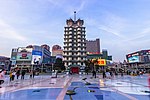Fawang Temple
This article needs additional citations for verification. (February 2013) |
Chinese: 法王寺 | |
 The temple entrance from the south. In the background is the Taishi range. | |
| Alternative name | English alternatives are Fa Wang or Fa-Wang and monastery instead of temple. |
|---|---|
| Location | Mount Song |
| Region | Dengfeng, Henan, central China |
| Coordinates | 34°30′08″N 113°01′36″E / 34.50234174969901°N 113.02676773893673°E |
| Part of | UNESCO global geopark |
| History | |
| Founded | Tang dynasty |
| Site notes | |
| Condition | Restored |
| Ownership | People's Republic of China |
| Public access | Paid admission |
Fawang Temple (Chinese: 法王寺) is a modern Chinese Buddhist monastery located 5 km (3.1 mi) northwest of the town of Dengfeng in Henan province, China. Situated at the bottom of the Yuzhu Peak of Mount Song, the monastery claims to be the descendant of the ancient Buddhist monastery founded under the Tang dynasty at this location. It inherited the name of Master Fawang, who was instrumental in imparting its Kung Foo lifestyle.
Today's institution is a complex aligned in a N-S direction. It consists of multiple modern facilities. A school of Shaolin Kung Fu, or martial arts, is located there, which has been there in some form more or less continuously since the Tang dynasty. Originally founded to train elite soldiers for the Emperor's army, it now trains participants in the international sport of martial arts, which have little place in modern armies using firearms, explosives, and advanced machines. They claim to add a warrior frame of mind that might still be useful; however, despite the English name of "martial arts," and the much vaunted warrior creed, no modern army recommends, teaches, or uses this creed. The last army to do so was the Japanese in World War II. The high-ranking officers spent some time in Zen meditation. All officers wore swords and knew the art of swordsmanship. After the catastrophic ending of the war Japan renounced the military, while the Samurai creed (except for Japanese martial arts, a sport) fell into disrepute. The tatooed warriors generally appear in fiction as gangsters. Buddhism remains a religion practiced on a personal level.
The revolutionary government of the People's Republic of China has varied in its approach to this and other Buddhist monasteries. Mao Zedong ignored Kung Foo as a method of serious fighting, advising his soldiers strike solid blows instead. Subsequently Mao made it known that he valued the monasteries as a Chinese tradition, and was seen touring them. however, the Cultural Revolution devalued them. That policy was reversed on Mao's death. Currently the government appears to be supportive to the monasteries as cultural assets. Certainly, the Mount Song region has become a major tourist center. Under government jurisdiction since 1949, the monasteries generally receive all the funding they need. In return they generate a large geotourism income. The monks to some degree have become showmen and acrobats. They give special displays and shows dressed in costume or with body paint and evidence considerable acrobatic agility. During the early 21st century Mount Song became a UNESCO global geopark, which requires a commitment to geotourism.
Despite their committment to showmanship and geotourism the monasteries remain primarily educational institutions, similar to religious educational institutions elsewhere. The students are full-time residents. Foreigners are accepted. Many children are accepted. They must be taught reading, writing, and arithmetic as well as Buddhism. The monastery thus to some degree resembles a boy's school, with uniformed students under discipline, ensured by watchful Buddhist teachers.
Pagoda of Fawang temple

The temple has its own pagoda forest (distinct from that of the Shaolin Temple)[1] located up the slope to the north at 34°30′26″N 113°1′11″E / 34.50722°N 113.01972°E. The Fawang Temple pagodas were built mainly during the Tang dynasty (618–907), but some are later, in the Yuan dynasty (1271–1368).
The most prominent of these early Tang era pagodas is a 40 m (131 ft) tall square-based stone tower with eaves, its ground floor measuring 7 m (23 ft) on each side with 2 m (6.5 ft) thick walls. Inside this pagoda is a shrine and a jade statue of the Buddha that was presented to the pagoda in 1409 by a member of the royal family stationed in Luoyang during the Ming dynasty. This pagoda follows the similar design style of other Tang pagodas, such as multi-eaved, square-based Xumi Pagoda and Small Wild Goose Pagoda. Other Tang pagodas include three one-story pavilion style brick pagodas, each about 10 m (32 ft) high. Each one of these is capped with a conical roof with arc eaves.
History of the institution
Despite the many refurbishments and improvements remnants of the ancient structures remain, such as the southern gate with its hexagonal windows, Roman-arch doorway (though not built under any western influence), ornate roof, and grand staircase guarded by stone mythical creatures. The similarity of this gate to a parallel gate in the nearby Shaolin Monastery suggests a common architecture and common period of foundation. The bundling together of these two temples with two others, the Songyue and Huishan, under the historical name "the Four Temples of Mount Songshan" is believed to indicate they were all formed in the same period, and further, they represent the introduction of Chan Buddhism to the area.[2] The introduction of the name into history, however, is not dated.
The pagodas in the cemetery are studied as Tang dynasty architecture.
See also
References
- ^ China Internet Information Center. "Tang Dynasty Tomb Pagodas at Fawang Temple in Dengfeng of Henan Province". China Through a Lens. Retrieved 19 September 2022.
- ^ Ren & We 2021, pp. 94, 96
Reference Bibliography
- Ren, Wei; He, Yan (2021). Historic Monuments of Mount Songshan. Shanghai: Shanghai Far East Publisher.


